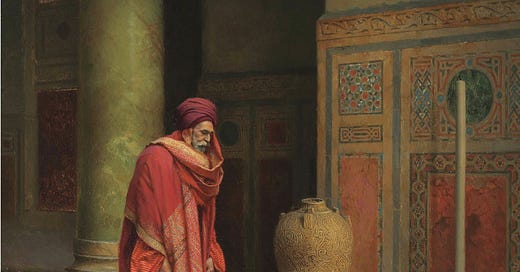Born in Austria - settling in Paris - but profoundly influenced by his travels through Egypt and the Middle East during the late 1800s.
Ludwig Deutsch is far from a household name, even amongst many art scholars. And, while the majority of his career was dedicated to painting in an academic “orientalist” style - admittedly, his work is sometimes a little hit and miss.
In fact, for most of his life, he lived somewhat in the shadow of other great painters of the day - not least his hero Jean-Léon Gérôme (Who was arguably the most famous academic artist in the world at one point).
But, with today’s work - painted later in his career, when the artist was 67 years old - we find him, at last, reaching a whole new pinnacle.
A painting which truly deserves the title of masterpiece.
(And, also, serves as perfect evidence that age really is just a number! Thus, while some artists may peak in their 20s. . . others do not even begin to hit their stride until 60s or 70s!)
It is worth mentioning that many of the compositional elements in this painting can be found in Ludwig’s earlier works too - from the elaborate Persian carpet, to decorative walls, and the modestly beautifully amphora/jug in the background.
They speak of the artist’s personal experience of wandering inside temple spaces just like this - immersing himself in this sights, sounds, and smells he had come to adore so much.
And, indeed, his work often includes items that he brought back himself, as souvenirs from the countless visits he made to the middle east.
But, while the composition may not have been entirely new - and Ludwig had actually tackled this scene of a man at prayer a handful of times before - nonetheless, what he achieves here is something far beyond all those earlier attempts.
While earlier works are, of course, wonderful pieces in their own right - with his 1923 version, Ludwig strayed into the sublime.
The colours are warmer, with more of a complimentary balance.
The details are more beautifully painted.
The lighting - and, indeed, the shadows - feel somehow warmer.
And, most of all, it is the deep silence - and the profoundly meditative feeling we get from this painting - which makes it truly exceptional.
With his man at prayer - Ludwig is reminiscing on all the wonders he had seen in his life; blessed to have visited those places - but also, no doubt saddened to think that he may never see them again.
He is painting from memory, experience, imagination, and academic research all at the same time.
And, more profoundly, he is offering us the space to take this moment of reflection with his man too.
Perhaps to step into our own memories.
Or to say our own prayer.
Or to remember that the world is ever changing - but the spirit of life is constant.









Thanks for introducing another beautiful and worthy work of art. The figure may be praying to the Creator, but the artist as creator is expanding the world; and your commentary is bringing that creation to light.
When I scrolled down to the first image, my reaction was, "Wow!" The detail and skill required to achieve it is completely awesome, to use an over-used expression.